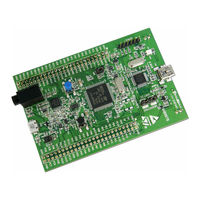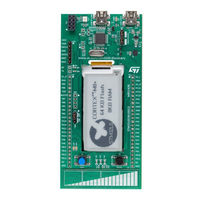ST STM32F3 Series Manuals
Manuals and User Guides for ST STM32F3 Series. We have 5 ST STM32F3 Series manuals available for free PDF download: Programming Manual, Application Note
ST STM32F3 Series Programming Manual (260 pages)
Cortex-M4
Brand: ST
|
Category: Computer Hardware
|
Size: 3 MB
Table of Contents
-
-
-
-
Stacks16
-
Data Types25
-
Memory Model27
-
Bit-Banding31
-
-
-
-
Operands59
-
-
-
Adr69
-
LDM and STM75
-
PUSH and POP77
-
Clrex79
-
-
Clz86
-
CMP and CMN87
-
MOV and MVN88
-
Movt90
-
TST and TEQ98
-
UASX and USAX100
-
UHASX and UHSAX102
-
Sel104
-
Usad8105
-
Usada8106
-
USUB16 and USUB8107
-
-
SMLA and SMLAW111
-
Smlad113
-
SMLAL and SMLALD114
-
SMLSD and SMLSLD116
-
SMMLA and SMMLS118
-
Smmul119
-
SMUAD and SMUSD120
-
SMUL and SMULW121
-
SDIV and UDIV123
-
-
SSAT and USAT125
-
QADD and QSUB127
-
QASX and QSAX128
-
QDADD and QDSUB129
-
UQASX and UQSAX130
-
UQADD and UQSUB131
-
-
Vabs150
-
Vadd151
-
Vcmp, Vcmpe152
-
Vcvtb, Vcvtt155
-
VDIV156
-
Vfma, Vfms157
-
Vfnma, Vfnms158
-
Vldm159
-
Vldr160
-
Vlma, Vlms161
-
VMOV Immediate162
-
VMOV Register163
-
Vmrs168
-
Vmsr169
-
Vmul170
-
Vneg171
-
Vpop173
-
Vpush174
-
Vsqrt175
-
Vstm176
-
Vstr177
-
Vsub178
Advertisement
ST STM32F3 Series Programming Manual (262 pages)
Brand: ST
|
Category: Computer Hardware
|
Size: 2 MB
Table of Contents
-
-
-
-
Stacks17
-
Data Types26
-
Memory Model28
-
Bit-Banding32
-
-
-
-
Operands60
-
-
-
Adr70
-
LDM and STM76
-
PUSH and POP78
-
Clrex80
-
-
Clz87
-
CMP and CMN88
-
MOV and MVN89
-
Movt91
-
TST and TEQ99
-
UADD16 and UADD8100
-
UASX and USAX101
-
UHASX and UHSAX103
-
Sel105
-
Usad8106
-
Usada8107
-
USUB16 and USUB8108
-
-
SMLA and SMLAW112
-
Smlad114
-
SMLAL and SMLALD115
-
SMLSD and SMLSLD117
-
SMMLA and SMMLS119
-
Smmul120
-
SMUAD and SMUSD121
-
SMUL and SMULW122
-
SDIV and UDIV124
-
-
SSAT and USAT126
-
QADD and QSUB128
-
QASX and QSAX129
-
QDADD and QDSUB130
-
UQASX and UQSAX131
-
UQADD and UQSUB132
-
-
Vabs151
-
Vadd152
-
Vcmp, Vcmpe153
-
Vcvtb, Vcvtt156
-
VDIV157
-
Vfma, Vfms158
-
Vfnma, Vfnms159
-
Vldm160
-
Vldr161
-
Vlma, Vlms162
-
VMOV Immediate163
-
VMOV Register164
-
Vmrs169
-
Vmsr170
-
Vmul171
-
Vneg172
-
Vpop174
-
Vpush175
-
Vsqrt176
-
Vstm177
-
Vstr178
-
Vsub179
ST STM32F3 Series Programming Manual (262 pages)
Brand: ST
|
Category: Computer Hardware
|
Size: 2 MB
Table of Contents
-
Stacks17
-
Data Types26
-
Memory Model28
-
Bit-Banding32
-
Vector Table40
-
Fault Types45
-
Lockup47
-
Operands60
-
Adr70
-
LDM and STM76
-
PUSH and POP78
-
Clrex80
-
Clz87
-
CMP and CMN88
-
MOV and MVN89
-
Movt91
-
TST and TEQ99
-
UADD16 and UADD8100
-
UASX and USAX101
-
UHASX and UHSAX103
-
Sel105
-
Usad8106
-
Usada8107
-
USUB16 and USUB8108
-
SMLA and SMLAW112
-
Smlad114
-
SMLAL and SMLALD115
-
SMLSD and SMLSLD117
-
SMMLA and SMMLS119
-
Smmul120
-
SMUAD and SMUSD121
-
SMUL and SMULW122
-
SDIV and UDIV124
-
SSAT and USAT126
-
QADD and QSUB128
-
QASX and QSAX129
-
QDADD and QDSUB130
-
UQASX and UQSAX131
-
UQADD and UQSUB132
-
PKHBT and PKHTB135
-
SXT and UXT136
-
SXTA and UXTA137
-
BFC and BFI139
-
SBFX and UBFX140
-
SXT and UXT141
-
CBZ and CBNZ144
-
TBB and TBH147
-
Vabs151
-
Vadd152
-
Vcmp, Vcmpe153
-
Vcvtb, Vcvtt156
-
VDIV157
-
Vfma, Vfms158
-
Vfnma, Vfnms159
-
Vldm160
-
Vldr161
-
Vlma, Vlms162
-
VMOV Immediate163
-
VMOV Register164
-
Vmrs169
-
Vmsr170
-
Vmul171
-
Vneg172
-
Vpop174
-
Vpush175
-
Vsqrt176
-
Vstm177
-
Vstr178
-
Vsub179
-
Bkpt181
-
Cps182
-
Dmb183
-
Dsb184
-
Isb185
-
Mrs186
-
Msr187
-
Nop188
-
Sev189
-
Svc190
-
Wfe191
-
Wfi192
-
Core Peripherals193
-
MPU Mismatch196
Advertisement
ST STM32F3 Series Application Note (52 pages)
Getting started with touch sensing control on STM32 microcontrollers
Brand: ST
|
Category: Microcontrollers
|
Size: 4 MB
Table of Contents
-
-
6 Tuning
23 -
-
Uses Cases24
-
-
-
ST STM32F3 Series Application Note (56 pages)
Brand: ST
|
Category: Microcontrollers
|
Size: 3 MB
Table of Contents
-
Overview5
-
Trustzone32
-
Core State33
-
Firewall35
-
Device ID40
-
Cryptography40
Advertisement




